Last Updated on December 13, 2023.
Transparent Language
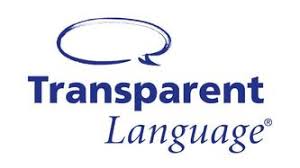
Summary
Transparent Language markets itself as “the most complete language-learning system for independent learners.” While there are lots of different exercises for you to work through in their Essentials Course, I thought that the material wasn’t all that helpful and that it got very repetitive. Although the courses might not be all that useful or in-depth, with over a hundred languages on offer it might be worth checking out if you want to learn the very basics of a more obscure language such as Buriat, Kazakh or Turkmen.
While the exercises are for the most part well-designed, diverse and easy to use, it is the core material itself that I found lacking.
I hardly came across any explanations at all; practice was almost exclusively memorizing words and phrases.
I would only consider using if I was studying a very rare language.
I Like
- I really like the fact that they offer up courses in languages that are usually overlooked.
- It’s pretty well-designed, easy to use and has lots of different activities to work through.
I Don’t Like
- The core material is severely lacking in my opinion; it’s hard for me to imagine you’ll learn much grammar or how to form even a basic sentence yourself.
- It gets very repetitive and so I didn’t find it that fun to work through.
- You learn virtually nothing about the different cultural contexts of the languages you’re learning.
- Their teaching methodology was the biggest issue for me, leaving you memorizing lots of words and phrases in isolation.
Price
There is a free two-week trial period for you to try it out. Otherwise, it is $24.95 per month or $149.95 for a whole year if you just select one language. If you want access to all of the languages it is then $49.95 per month and $249.95 a year.
Table of Contents
To see all of our favorite programs, online subscriptions, apps, podcasts and YouTubes for the language you’re learning, look for your language in the table below.
Most Recommend Resources By Language

While the various exercises will teach you to read, write, understand and speak various words and phrases in your target language, the grammar and the structure of the language is ignored almost entirely or is only included seemingly as an afterthought.
This means that you only learn to say or write words in isolation. There is very little chance that you’ll actually be able to have much of a conversation after having gone through all the material.
The heavy use of repetition also makes it quite tedious to go through lessons in my experience, and after working through nine different exercises, you’ll still only have learned the words you were presented with in the beginning.
Basically, I found the whole course for each language I tried to amount to an endless exercise in memorizing word lists.
Although you would almost certainly learn some useful words and phrases, I just can’t recommend using these courses as I don’t think they’re all that helpful. There are lots of language learning apps that I’d rather use.
The only time it may be worth checking out is if you’re looking to learn the basics for a more obscure language. Even then, I wouldn’t be reluctant to use Transparent Language.
Course Overview
You can access the Transparent Language courses online or through the app. Both feature a sleek, modern design with intuitive and easy to use features.
While the amount of content varies by language, all the Essentials Courses have an almost identical format for you to work through.
The bulk of the content is found in the ‘My Learning Path’ section where you’ll find various units on topics such as ‘Organize Your Trip’, ‘Staying at a Hotel’ and ‘We’re Going Shopping’. While most languages seem to have eleven units (this is the maximum as far as I can tell), some such as Brazilian Portuguese do have less.
Each unit has around three or four lessons for you to work through. Each of them have around six to nine lots of exercises.
You can progress through the course in a linear way, but the program also offers new customizable features as well. This allows you to select a topic you want to learn about and get a custom lesson on that, instead of just working your way through the course.
The lessons usually start off with a ‘Language Comparison’ before you go through the topic more carefully in ‘Preview It’ before learning how to say it yourself in ‘Pronunciation Practice’.
After that come various exercises such as ‘Four Square’, ‘Pronounce & Say It’ and ‘Unscramble’ and these all take slightly different formats but they ideally get you reading, understanding, speaking and remembering the same words and phrases from the start of the lesson.
Certain exercises such as ‘Dictation’ also help you learn how to write the words down. We’ll take a look at all of these in a bit more detail in the rest of the review.
The idea behind the Essentials Courses seems to be that language learning should be fun, engaging and interactive, and they’re shown as being appropriate for beginners to start using immediately. While a focus is placed on essential vocabulary and pronunciation, some grammar points are addressed as well under the ‘Browse’ section.
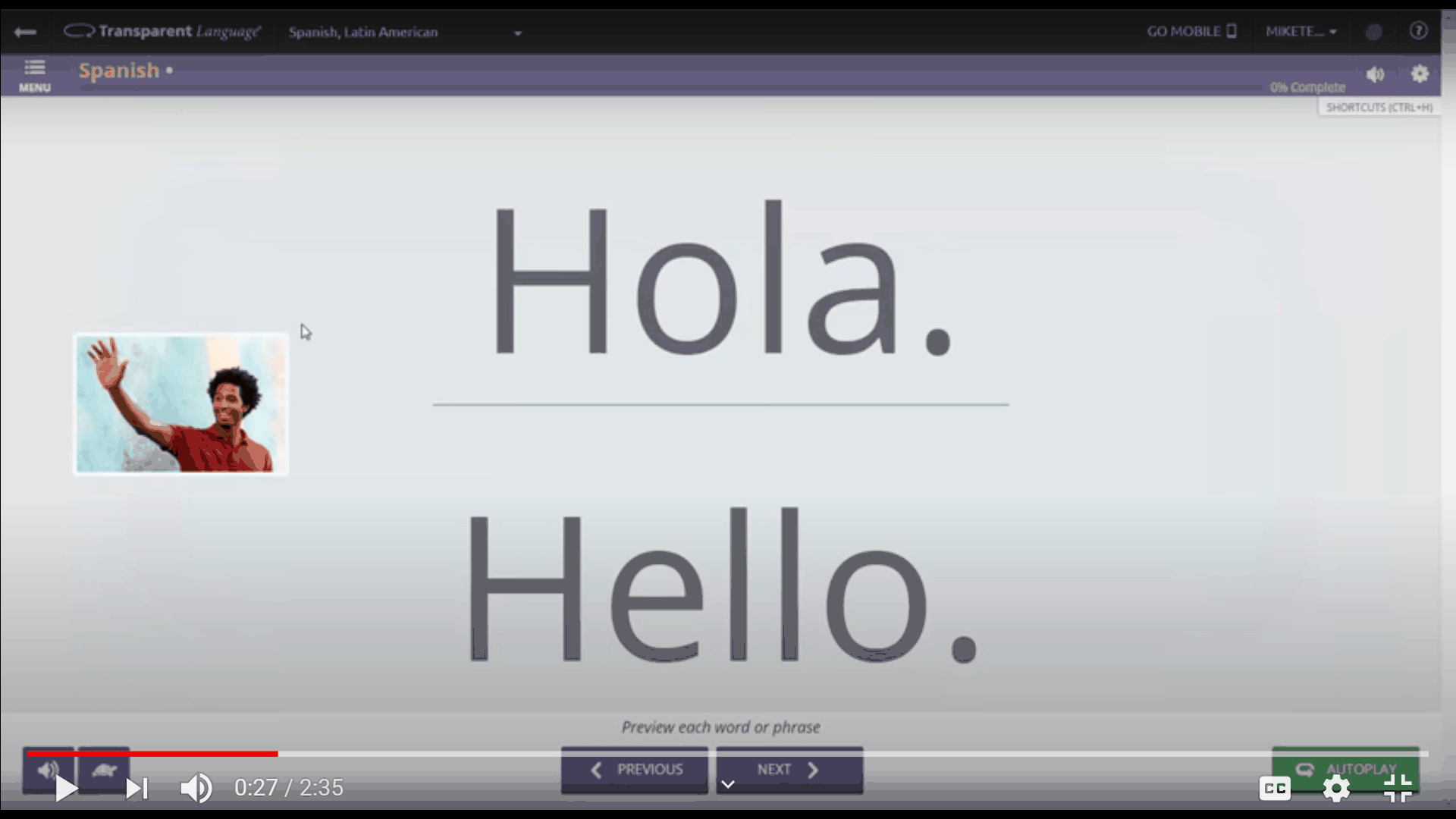
Let’s now take a look at what the lessons actually look like.
Getting Started
After you have signed up to the Transparent Language Essentials Courses, you are greeted with a welcome page that shows you your learning path.
At the top of the page, you will see the language that you have selected and if you click on that, you can always try out any of the other languages that the platform offers. I decided to follow both the Portuguese and Russian courses to see what they were like.
There are no settings to choose from as all of the languages start off right from the beginning; you can skip ahead if you want or slowly work your way through the learning path that they’ve come up with.
Both of the welcome lessons in Portuguese and Russian were exactly the same. They teach you how to say and understand the following words – hello, yes, no, thank you, and the name of the language you’re learning, so Portugues or Russkiy.
In this particular lesson, you are first introduced to each word with their English equivalent written alongside it.
This is the ‘Language Comparison’ part of the lesson. You click to go to the next section and an uplifting sound plays to indicate that you’ve completed it.
Following this is the ‘Preview it’ section where you see each word individually and it is read out by a native speaker.
Next up is the ‘Pronunciation’ section where you read and listen to the word before recording yourself saying it. A little speedometer on the right indicates how well you did and the sound waves. I suppose this is so you can try and say the word as similarly as possible to the native speaker.
I wasn’t completely convinced at how accurately they rated your pronunciation through the speedometer method, but it was quite visually interesting to see in any case.
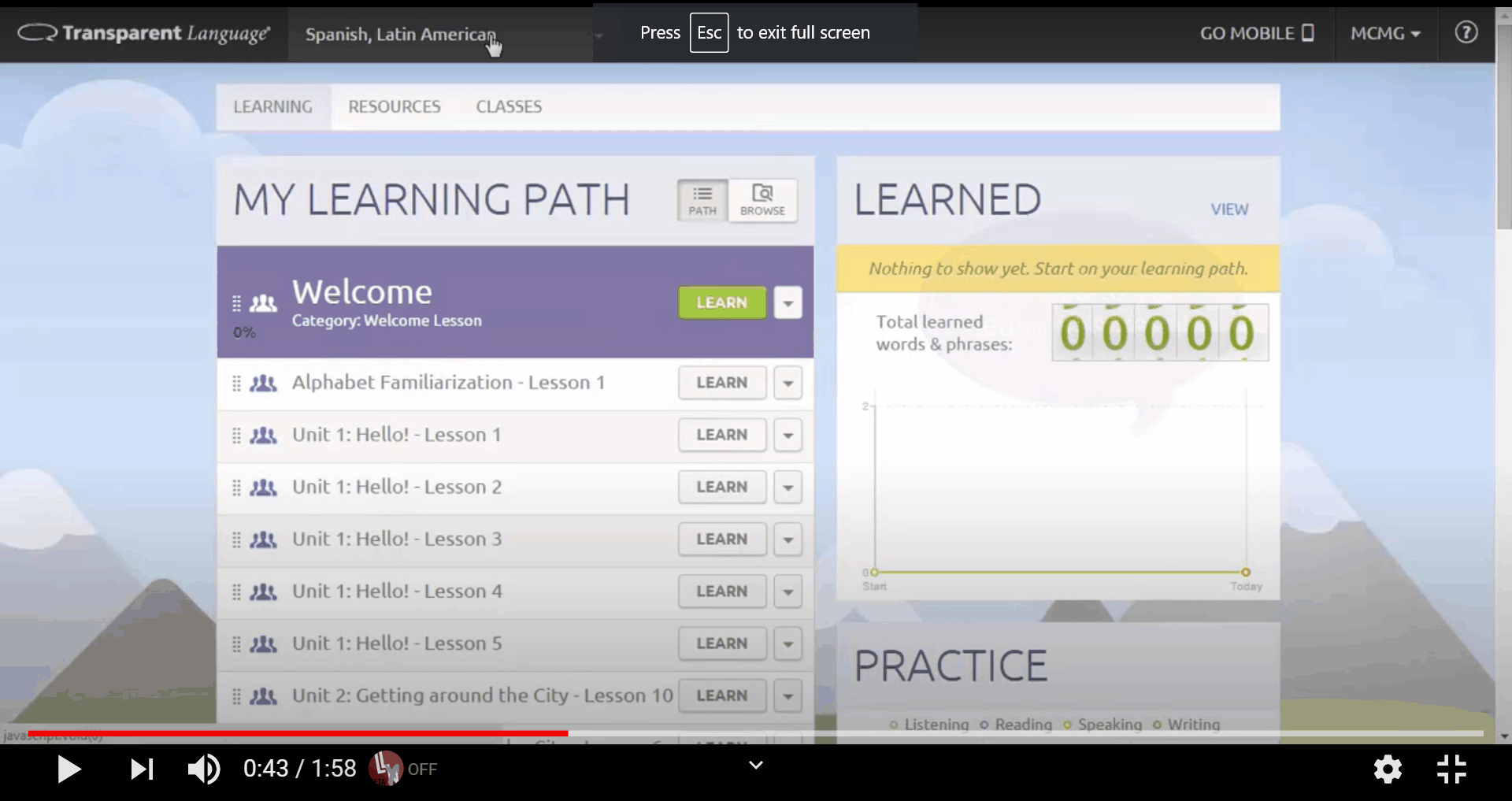
After this step comes the ‘Listening Recognition’ part of the lesson where you listen to a native speaker say the words you’ve just gone over and select the correct meaning.
In the following ‘Matching’ section you then have to match the Russian or Portuguese words with their English equivalent.
The final part of the lesson is the ‘Produce & Say It’ section where you see the word written in English and have to say it in the language you’re learning before clicking to hear a native speaker say it to see whether you’ve got it right or not.
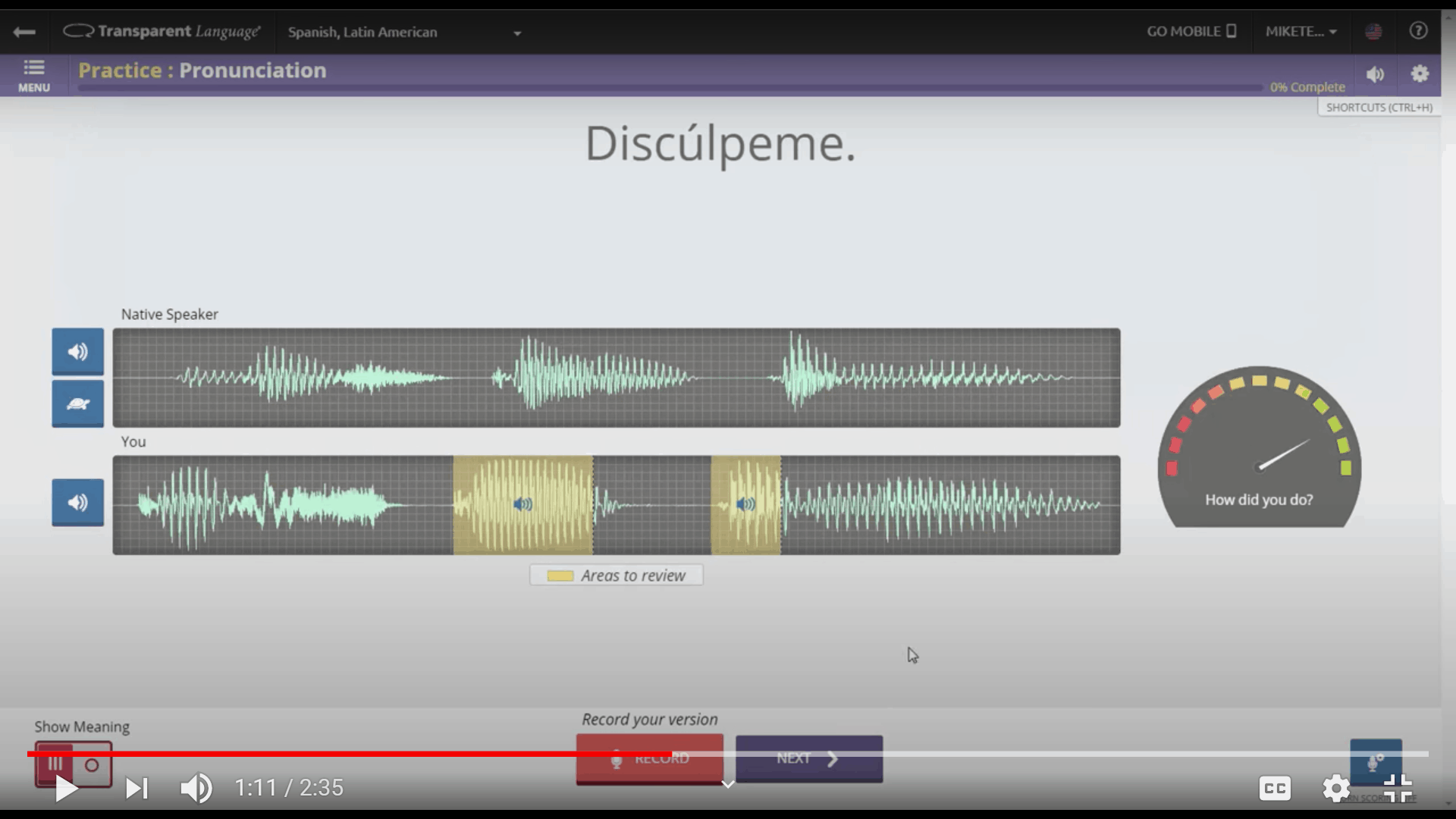
While I liked that there were different elements involved in the welcome lessons, the first class did get a bit monotonous as they really hammered home these five words again and again and again.
As each lesson was also identical, it made me a bit worried that perhaps all of the hundred+ language courses on the platform taught you exactly the same words and phrases in each language.
First up in Lesson 1 of the Russian course you have a ‘Language Comparison’ section where you can see the words and phrases you’re going to learn written in English and Russian.
After playing through the audio to hear what they sound like, the ‘Preview it’ section again shows you the words and audio of a native speaker saying the words again. You then pronounce the words yourself and you can see how accurately you do.
Next up came a slightly different matching game called ‘Four Square’ where the words on the four squares flash up one-by-one before you and then turn over again.
After this, you are told to select the one which corresponds to the English word you are now given.
I did absolutely terrible at this memorization game and struggled to correctly identify phrases like “mne nuzhna pomashch’ and “ya pamuchil travmu.” While I quite enjoyed the rapid pace, there was, unfortunately, no way of slowing it down, which I think would have helped at least a bit.
Following this, you then have the ‘Pronounce & Say it’ section where you try and remember what you’ve just learned, saying it out loud before the audio confirms whether you’re right or wrong.
The final section of lesson 1 is a ‘Dictation’ part where you again listen to the words and phrases that you’ve just gone through and write them down. As you can tell, there is a lot of repetition involved and while each of the sections is quite similar to the others, there are some small differences.
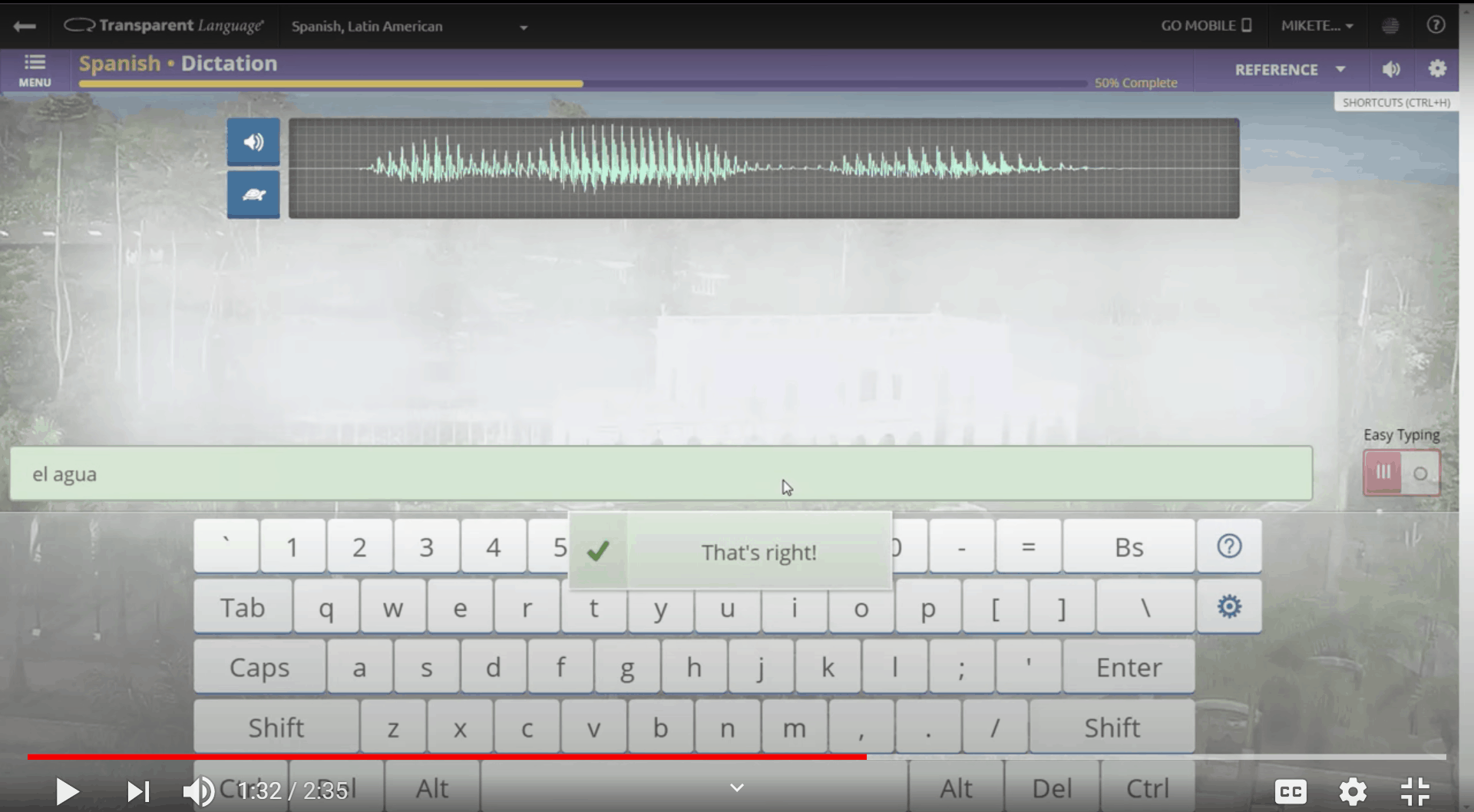
The Brazilian Portuguese course begins slightly differently as you start off with a conversation where James, an exchange student, meets Flavio, a fellow student at the university. This teaches you introductions and gives you an idea about how people greet each other in Brazil.
To me, this seems a more logical start point than learning about accidents in the Russian course.
After this you again work through a ‘Language Comparison’, ‘Preview it’ and ‘Four Square’ before a ‘Sentence Unscramble’ where you put the words in the correct order. Next up is pronunciation practice, before you then ‘Produce & Say it’ and then write down all the words in a dictation.
The final step of the nine parts of lesson one is a ‘Conversation Practice’ section where you choose one of the two characters to play, and you again record yourself saying the sentences. A cool feature is that you can then play back the whole audio and hear yourself seamlessly taking part in the conversation.
While the first lessons in Unit 1 for both Portuguese and Russian relied heavily on repetition, they did get you interacting with the material in a number of different ways with writing, listening, speaking, understanding, pronunciation and reading all featuring.
Let’s take a look at what some of the later lessons look like.
A Closer Look at Later Lessons in the Courses
Continuing with the early Russian lessons, I was surprised to see how much information I’d actually managed to retain when it came to taking the first assessment.
These come up at the end of each unit and you get to see just how much information you’ve learned. The dictation part surprisingly wasn’t a complete disaster and I suppose the heavy use of repetition must have helped as I’d probably seen or heard each word or phrase about fifty times or more.
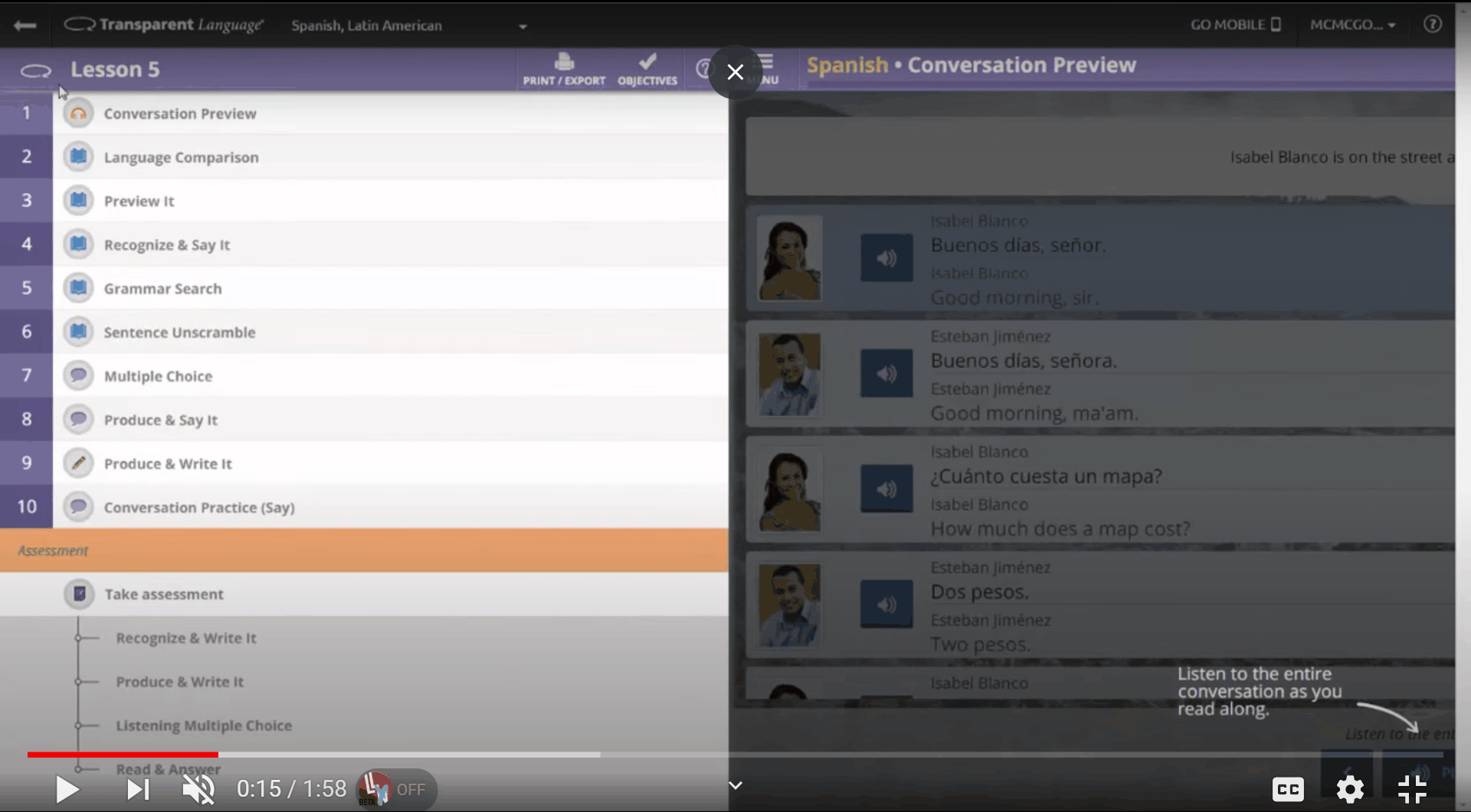
One thing that I didn’t like in these early lessons was that some of the vocabulary wasn’t that important and there are definitely a lot more useful words and phrases that could have been taught instead.
As an absolute beginner, I was a bit put off and demoralized having to work my way through words such as ’emergency’ which I really didn’t feel had to be included so early on.
Trying to read, perfectly pronounce and write ‘chrezvychaynaye praishestviye’ was the stuff of nightmares and it seemed that no amount of repetition would hammer it into my head.
You also never explicitly learn how to connect the vocabulary together. So, you’ll learn ‘I want to buy’, ‘hungry’ or ‘bread’ but not how to say ‘I am hungry’ or ‘I want to buy bread’.
In fact, all the words and phrases that you see at the beginning of the lessons are all that you will come away learning each time. You don’t ever get to see them used in context or in a sentence, only in isolation.
While there are lots of different exercises to work through in each lesson, this essentially means that you could simply sit down and memorize how to write, read, say and understand them without working your way through the various sections.
While the vocabulary in the first unit seemed a bit random to me, the other ten units that make up the Russian course are all geared to helping you learn practical words and phrases as the units look at such topics as ‘Getting Around in the City’, ‘Dealing with Money’ and ‘Eating Out’.
Unfortunately, every unit follows almost exactly the same format so while there are a couple of different types of exercises that pop up from time to time such as ‘Recognize & Write It’ and ‘Multiple Choice’, they pretty much all amount to the same thing.
Everything essentially boils down to memorization and repetition.
Grammar, for instance, doesn’t come up at all in the Essentials course, and we aren’t actually taught how the Russian language works in practice, we just memorize the words and phrases that were given at the beginning of the lesson.
Disappointed at what the core lessons amounted to, I started exploring the rest of what the platform had to offer and under ‘Browse’ I found a huge list of General Vocabulary.
The various sections had useful words and phrases for everything from verbs, adjectives and grains (?!) to Helper Relationship Facilitation (?!), buying tickets and languages.
While these weren’t particularly interesting to go through as they featured all of the same repetitive exercises as before, it was good to see that there were more than just the core lessons available.
I also stumbled across some grammar points and an explanation as to how the Cyrillic alphabet works and what each letter sounds like.
While these were better than nothing, the resources could have been improved upon and I was surprised to see that all of the grammar was tucked away, hidden and out of sight.
The ‘Grammar Tips’ as they are called are nineteen videos which are forty seconds to two minutes in length and while they at least give you some pointers on how Russian works, they don’t delve into much detail, are quite dry and boring and seem more like an afterthought than anything else.
I did quite enjoy using the Alphabet Explorer which is a game that teaches you the Cyrillic alphabet.
Under ‘Browse’ there is also a ‘Grammar Reference’ section and here you can find a bit more (not much though) information on conjugations, prepositions, pronouns, adverbs, and adjectives, etc.
Whereas the main core units had lots of parts to them, albeit all being very similar, these grammar references had a very stripped back feel to them and it seemed that they’d felt obliged to add some grammar points but hadn’t really put their heart into it.
The fact that the only grammar on the platform is hidden away under ‘Browse’ and not included under ‘Learning’ also seems to indicate this.
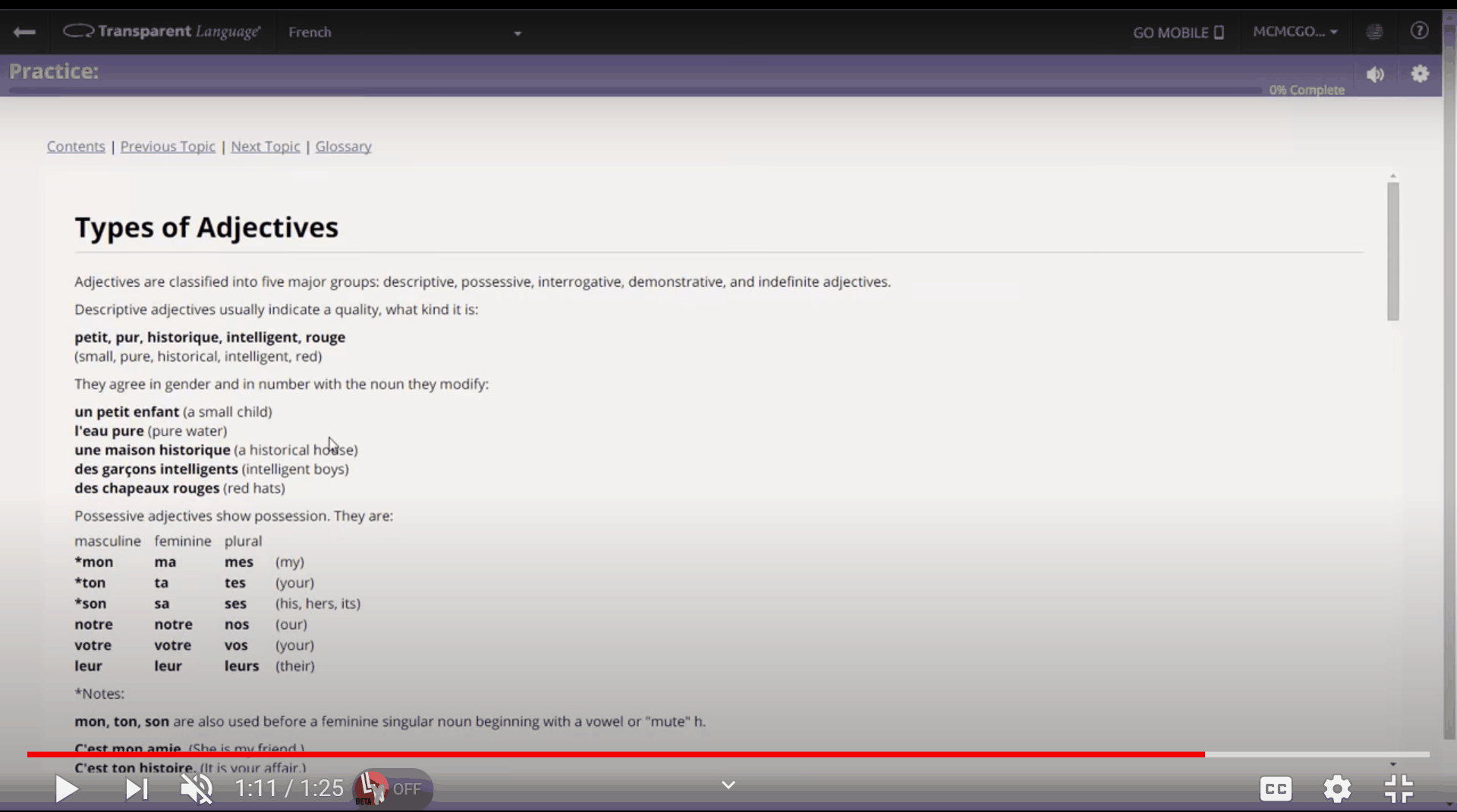
Unfortunately, the Portuguese course ended up being almost identical to the Russian one in terms of how the lessons were presented, the vocabulary included and the endless repetition that you were expected to go through.
Again, you just learn the words and phrases in isolation without learning any grammar at all or how to break down and actually use the words in another context.
The words and phrases that were used were also very similar to the Russian course with the only real difference being that each lesson started off with a very short dialogue and terminated with you taking part in that very same conversation.
The only other difference was that there are only seven units in the Portuguese course for you to work through in contrast to eleven in the Russian course.
Under ‘Browse’ there was again the huge list of General Vocabulary, Grammar Tips and Grammar References, all of which again appeared to have been very much an afterthought.
The brief explanations they gave you on prepositions or adverbs again felt incomplete and as if they had been lifted from a particularly dry and boring textbook.
There were a couple of extra additions for the Portuguese course under ‘Essentials’ and here I found an e-Workbook and a Portuguese Essentials Reader.
The former actually seemed to tie everything together as the vocabulary from the core lessons were used, it made reference to the grammar points and advised you to watch the grammar tip videos before working through some written exercises that it gave you to do.
While it did essentially add up to a very basic textbook, I was surprised that it wasn’t more prominent on the platform and that it was again tucked away out of sight. Strangely it also referred to eleven units although only seven exist on the platform.
The Essentials Portuguese Reader also referenced eleven core lessons and gave you some more written comprehension exercises to do as well as some short dialogues to read and analyze.
While these did at least progress in difficulty, unlike anything else I’ve seen on the platform, they were again quite short, and I imagine it would be more worthwhile working through a proper textbook than using it to learn Portuguese.
All in all, I came away quite disappointed with Transparent Language as I found the courses to be very monotonous to work through and I wasn’t all that impressed with the material which they looked at and how they introduced you to each language.
I was impressed at the number of different exercises they had and of course the amazing range of languages they covered. Indeed, they not only offer up courses into English but some of them are also available to Spanish, Turkish, Portuguese, or Arabic speakers to work through.
Having said this though, I think the platform would only really be useful to someone who was interested in learning one of the more obscure languages that they offer and even then, you would only really learn the very basics.
I didn’t find it very fun or useful to work through and while it is well-designed and sleek to use, it was the content at the heart of all the lessons that was the main problem.
All the lessons and activities basically got you memorizing the same words and phrases, repeatedly in a very repetitive manner and so even after working through nine exercises you’d still only have learned the same words as at the beginning.
For the price quoted, I really don’t think that they are offering ‘radically better language learning’ and you would definitely have to use a textbook or two and sign up for language classes if you wanted to get anywhere decent in your language of choice.
As such I think you are better off looking elsewhere for your language learning needs.
Plans and Prices
One of the best things about Transparent Language (apart from all the amazing variety of languages it offers) is the fact that there is a free two-week trial period where you can sign up and try all the languages you’d like.
This is great as you can then decide for yourself whether it suits your language learning needs without parting ways with any of your cash or giving away your credit card information.
If you do decide that you like it, then it costs $24.95 if you pay month-by-month and $149.95 if you sign up for a whole year. This, however, is for just one language but it does include the grammar lessons, core Essentials units, vocabulary lists and alphabet lessons that accompany it.
If you want access to all of the 100+ languages and all of the resources that accompany each course, it will set you back a little bit more. This then works out at $49.95 a month and a whopping $249.95 if you sign up for the whole year.
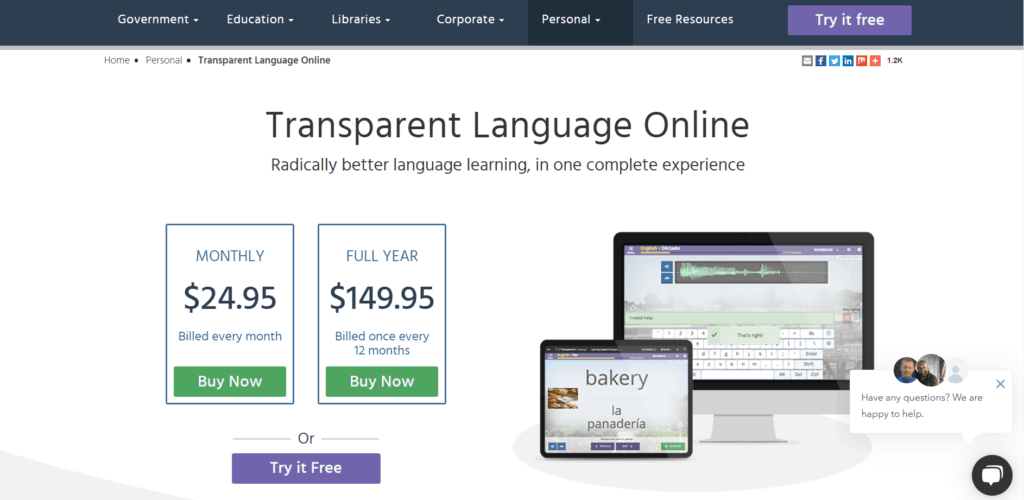
The company also offers pricing plans for libraries and businesses. It is worth looking into whether your local public library or workplace offers free access to Transparent Language.
While I do appreciate the fact that TL gives you access to so many different languages and so many often-overlooked ones at that, I unfortunately don’t think that it is worthwhile buying a subscription and that the prices are borderline insane.
This is because I found the material itself to be quite lacking and I don’t think I would even use it if it were free.
I would really only recommend it to people interested in learning one of the rarer languages that they offer up and even then, I think it would mainly only be useful for learning basic vocabulary as I don’t think you would even learn how to form a basic sentence structure from it.
Best Way to Use Transparent Language
If you decide to try Transparent Language because it is one of the few programs that offers a course in your target language, check out these tips to get the most out of your experience.
Supplement your learning with additional resources
The best way to gain a strong foundation in your target language while using TL is to find additional learning resources to use. First, you will want a resource that dives into grammar, in order to learn how to form complete sentences as you speak or write.
This is so important, because simply memorizing the vocabulary you learn through the TL lessons will not make you fluent in your new language! Many languages use unique word order in a sentence, require honorifics added onto words depending on who you speak to, or change word forms based on tense, person, or other factors.
A basic textbook may help, if you can find one. If not, you may want to pay for a few sessions with a professional tutor through a service like Italki. This app features tutors certified in many different languages, so chances are good you can find one in your target language!
Don’t be afraid to have fun
Second, you will probably want enrichment materials to keep your language-learning process fun. Since TL does not have the gamified style of a program like Duolingo, you can look for additional fun learning tools like stores in your target language. This series offers engaging short stories in multiple different languages.
You can also try free apps like Clozemaster to play sentence-structure games and boost your grammar knowledge.
Building your conversation skills
While TL does offer recordings of conversation spoken by native speakers, you need more than this to truly build listening comprehension skills. One great way to do this is to immerse yourself in the sounds of your new language.
If you can visit a part of the world that speaks your new language, go for it! If not, you can create a somewhat immersive environment of your own by surrounding yourself with music, TV shows, podcasts, or news media in your target language.
Alternatively, you could look for a language-learning program that focuses more on listening comprehension and conversion, like Pimsleur.
Practice, practice, practice!
Just like with any other language-learning program, TL works best if you reinforce your new skills through practice. One great way to do this is to put yourself in situations where you can hold real conversations using the words and phrases you just learned. If you live with or near people who speak your new language, this is easy!
If not, you can find conversation partners from all around the world on apps like HelloTalk. This free app lets you connect with fellow language learners and try out your vocabulary and pronunciation in a safe and non-judgmental environment.
Alternatives to Transparent Language
As you know from reading this honest review, Transparent Language is not the best tool you can use to learn a new language. Check out these alternatives that may offer you a better learning experience.
Pimsleur
As one of the oldest and most respected language learning methods around, Pimsleur has a lot to offer. The app-based courses consist of audio lessons with prompts encouraging you to speak, as well as lots of spaced repetition to reinforce what you learn. The app also includes activities, quizzes, and direct speaking software so you can get feedback on your pronunciation.
Pimsleur teaches some grammar but focuses primarily on listening comprehension and conversation skills. After completing a full course, you should have very basic fluency in your target language, and the ability to hold basic conversations on useful topics.
One reason Pimsleur makes a good alternative to Transparent Language is that Pimsleur also offers a wide array of language courses. Currently, you can choose from 51 different language courses. Pimsleur also costs slightly less per month than Transparent languages, and offers a much better overall introduction to a language. You can check out Pimsleur here.
Ouino
Ouino is a newer language-learning method available online or via app. The program only features five languages at the moment but will grow with time. This resource focuses on self-directed learning and will work well for someone who finds the boring repetition of TL too dull.
Ouino focuses on providing the core of what you need to learn as you approach a new language and recommends additional resources and environment you can add to bulk out your learning experience. It also takes a tailored approach to learning and allows you to customize your learning progression, rather than walking you through repetitive, boring lessons like TL.
The downside to Ouino is that you may not find a course in the language you want, especially if you want to learn a non-European language. If you want to give Ouino a try, click here!
Storylearning
Storylearning is another newer language-learning program that teaches all the elements of a language through story. The concept behind this method is that people communicate with each other through stories, so it makes sense that our brains can learn language best through narrative.
The big advantage Storylearning has over Transparent Language is that Storylearning covers all the key elements of a language, including grammar, pronunciation taught by a certified tutor/native speaker, and even culture and literacy.
However, Storylearning is an online course with no app. It does have sleek tools like direct-speaking software to provide feedback on your growing conversation skills. It will work best for a language-learner who needs a more engaging program that does not follow the textbook-like memorization method of a program like TL. If you want to give Storylearning a try, click here!
Final Thoughts
While I still am impressed at the sheer number of languages that Transparent Language offers up, I have come away a bit disappointed at what the courses themselves actually involve.
The activities, for instance, could be great if they simply mixed up the material a bit and actually taught you some grammar and how to form a sentence. By sticking to the same words and phrases over and over again, it gets very repetitive and monotonous to work through and you only really learn how to use each word in isolation.
The fact that TL teaches you to read, write, speak and understand the material through the activities they offer would normally be pretty impressive. It’s just a shame that they don’t actually teach you the structure of the language itself.
As such, it is very hard to recommend using the Transparent Language’s Essentials Courses and I really think the only people who could possibly benefit from it are those looking to learn the basics of a language like Tajiki, Dari or Denesuline.
If you plan to learn a more widely spoken language, check out a program like Pimsleur instead.

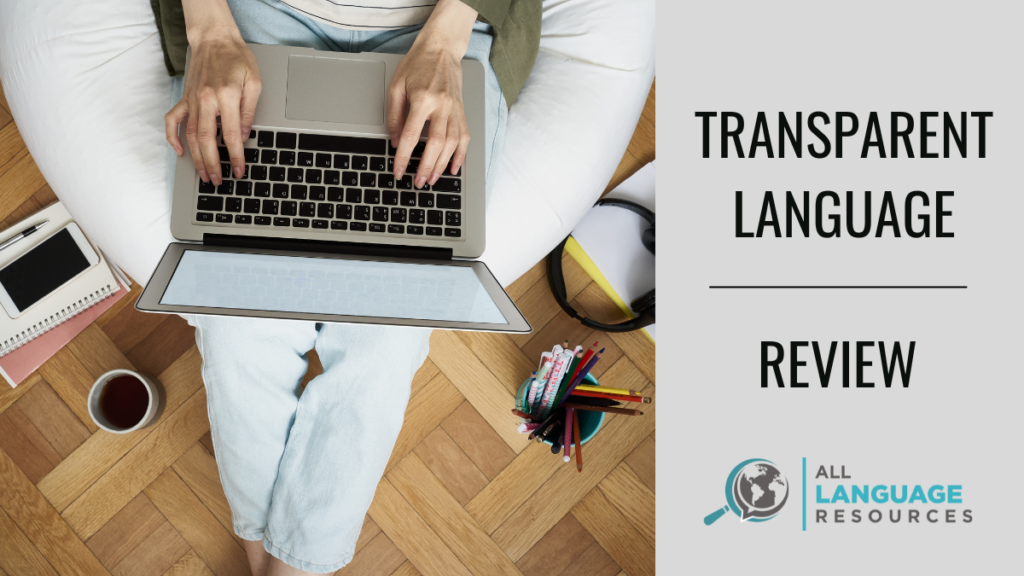
Transparent is also free for many people in the US and Canada from their library. They just need to use their library card number. They have a link on their site called find transparent, that you just put in your zipcode and see if your library has it.
While I am so far only trying out this website for Japanese, I like it a lot more than Duolingo for example. The reasons for this are that a) I am able to select any lesson I want so if I find the exercises too repetitive, I can skip them unlike with Duolingo that is just utterly boring and repetitive, with only a little of vocabulary introduced, b) I have to read through conversations written in Japanese even in the first units and c) the sentences actually make sense as opposed to Duolingo. Now, you are not saying that Duolingo is the best alternative to any language (usually rating it as second Tier), but I must say I would rate Duolingo very low. Lingodeer does look a bit better, but as there is no way to try out more than one lesson free and the first one looks a bit too simple (as opposed to this reading part of Transparent Language that I like very much), I’m a bit hesitant to try it. My experience from different apps is admittedly very limited so I can’t comment on any others, but I do speak multiple languages and have mostly learned them by reading books and, with languages like French where spoken language is hard to understand, by watching documentaries. So it might be that my learning style just is a better fit with this than more gamified experiences.
I also have so far gotten some explanations on grammar and cultural stuff like bowing and use of business card, which is a lot more than Duolingo (at least the app) offers, so I am bit surprised about those comments. I agree about the price being high and I have so far no idea of how advanced content this offfers so can’t comment about it.